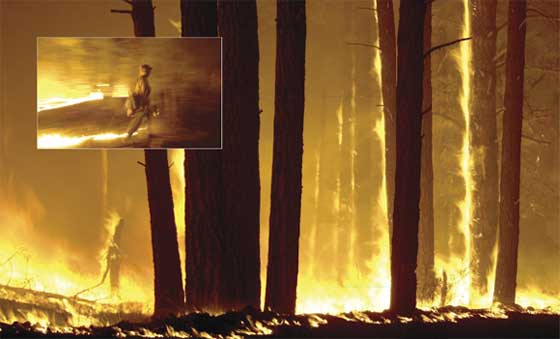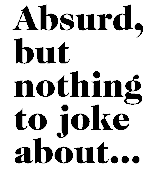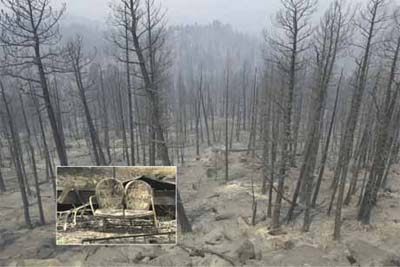|
|
|
| Subscriptions click here for 20% off! | E-Mail: info@rangemagazine.com |

The Rodeo Chediski fire in Arizona in June, Sitgreaves National Forest, burned 468,637 acres.
Photo: © Karen Wattenmaker <www.kwphoto.com>
 |
There’s no good reason for the fires to burn. By Tim Findley. Photos by Karen Wattenmaker. |
|
As much as two months ahead of the “natural” fire season in the West when a summer-baked forest might explode from a stroke of lightning, record-setting wildfires in Arizona and Colorado raged through regions the size of Los Angeles or Hiroshima. Each of the two largest fires were ignited by employees of the Forest Service itself. A third fire adding to Arizona’s heartache was set by a paid surveyor of spotted owls. The unnatural holocausts of June in western forests demanded blame and some form of punishment in the minds of thousands who were displaced or whose homes were lost, or whose simple love of the forests they once knew must now serve as a memory in their lifetime. Roaring ahead of the last lines held by exhausted, face-blackened fire fighters was frustration, anger, and even fury at a bureaucracy so helplessly compromised by promiscuous politics that all its paternalistic soothing seemed no more than brittle hypocrisy. “We have 40 million acres of fuel-loaded forests in the West right now,” Forest Service Deputy Chief Jim Furnish told Range in 2000. “If the question is: do we cut or do we let it burn, then the answer is burn.” It was dramatically one of the most candid responses ever received from the organization of then Forest Service Chief Michael Dombeck. Within months, half a million acres in Montana and Idaho had been lost to fire. This year’s toll was already worse before fire “season” began. Furnish and the Forest Service seem to be working their way through that 40 million acres, now estimated to be 70 million, in the manner both Dombeck and his benefactor, Bruce Babbitt, called “part of forest health”—burning half a million acres at a time. In 2000, that would finally total up to over eight million acres. To thousands of people from Montana to Arizona it seemed about as healthy as a good case of pneumonia might be for curing a cold. Claiming they were reacting to hysteria rather than expressing it, extreme green groups jumped on the fires by restating their fierce opposition to logging of any kind even before it could be suggested as a preventive act. Before he had said anything, the Native Forest Network attacked Bush Forest Service Chief Mark Rey as a tool of the timber industry, and suggested that his unstated policies to allow more logging to clear the overgrowth would amount to nothing less than “a criminal act.” Just so their side would be prepared, the Forest Network offered a list of 20 “scientists” they said would back their position on “healthy” fires. Those references included Andy Stahl, head of Forest Service Employees for
Environmental Ethics. Stahl, in his pre-Clinton persona as Director of the Sierra Club Legal Defense Fund, is considered the political wunderkind of actions using the spotted owl to halt logging in the Pacific Northwest. Other “scientists” to be used as references included Timothy Ingalsbee of the Western Fire Ecology Center, Todd Schulke of the Center for Biological Diversity, and others from the Wilderness Society and the John Muir Project. Among their arguments is that over the last 200 years, wildfires have decreased in frequency but increased in intensity. In mind-boggling fashion, they cite selective logging, grazing and the introduction of exotic plants as the reason. And to make sure the general public was not misled by legitimate complaints of those burned out in Colorado and Arizona, the Forest Network provided on its website a selection of pre-prepared letters to be sent to the media and political representatives. All you had to do to show how green you are is download one and add your signature protesting the “criminal acts” of fire prevention even being thought of by the Bush administration. Drought, roads, years of fire suppression, and good old global warming take the biggest blame from the coalition of greens, but since Clinton has gone part of their new message is that even Forest Service management should be eliminated on federal lands along with the roads and timber companies. Trust Andy Stahl and the other “scientists” who know best, the Forest Network suggests, and recognize that fire really isn’t a bad thing unless it gets too close to destroying houses. For that, the greens suggest that homes and communities should be seen as “natural firebreaks,” cleaned of all potential fuels for 100 feet around. “Instead of fuel breaks around the community, the community itself becomes the firebreak,” suggests Forest Service Research Scientist Jack Cohen. It sounds almost as if they suggest that people who dare to live near a forest should expect to sit on their aluminum deck some afternoon and enjoy a good “healthy” fire as part of the view—and part of the political tyranny surviving in the post-Clinton era. The arguments can hardly be made more absurd by the excuse of Forest Service worker Terry Barton claiming she was just burning love letters or by Native American part-time firefighter Leonard Gregg saying he was just setting a summer job for himself, or by spotted owl “surveyor” James Valdez just being upset with the Mescalero Apache. All three, after all, must have heard the Dombeck mantra of a “healthy” forest fire. It’s too absurd already when the site of the Pike National Forest where the Colorado Hayman fire began was the same area where environmentalists fought against state Department of Wildlife plans to thin the overloaded forest in the last two years. It’s too absurd when the Apache National Forest origins of the Arizona fire are in the same area where federal judges in the Ninth U.S. Circuit ruled two years ago that all logging and grazing should be banned. An author of that ruling was Justice Stephen Reinhardt, better known now as the concurring justice in the Ninth Circuit opinion this year banning recitation of the Pledge of the Allegiance in public schools. Does it need to get more absurd? “Natural” fires brought by lightning strikes should be expected to bring more havoc to the dry West as the summer ends. The protests of self-righteous extreme greens notwithstanding, firefighters will surely be on the lines again. Much of the western forest is waiting to explode with small and dying trees that the greens say would be useless to harvest anyway. The tallest old-growth may survive, if for no other reason than national will already pledged by years of green propaganda. And, in the end, there will still be vast regions of newer clotted growth left untouched—this year. There are no management plans for recovery or harvest of that which didn’t burn in the fires of June. The most hopeful difference in the coming “natural” season is that it is usually a prelude to winter. The short attention span of national news will not dwell long on such a western phenomenon, and that will be helpful to the campaign of media and political influence set cynically in gear this summer with “nonprofit” funds by the Native Forest Network and others. The public will forget, if it ever knew, that there are also vast forests in the northeast and southeast parts of the United States that somehow seem immune to such annual catastrophe, drought or no drought. Unlike the West, of course, most of that forest is privately owned. Perhaps the absurd answer in an extreme season in the West can be found in the serious question: who wants it to burn? Tim Findley was raised on a ranch in northern Utah and earned a degree in journalism from the University of Colorado in Boulder. |
|||||
|
Fall 2002 Contents To Subscribe: Please click here or call 1-800-RANGE-4-U for a special web price Copyright © 1998-2005 RANGE magazine For problems or questions regarding this site, please contact Dolphin Enterprises. last page update: 04.03.05 |
|||

